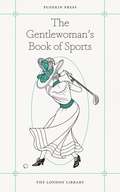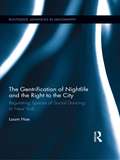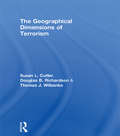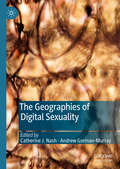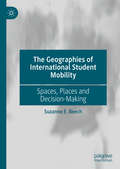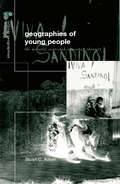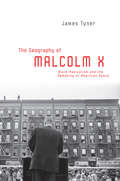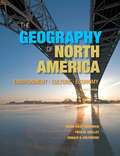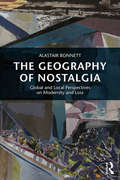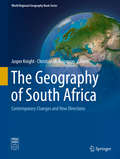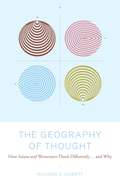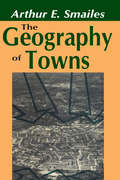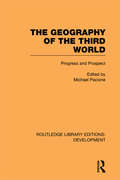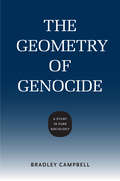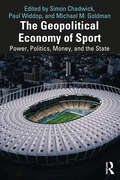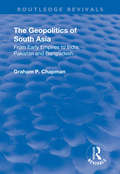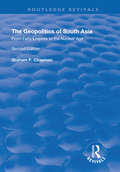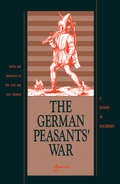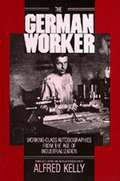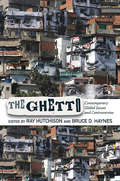- Table View
- List View
The Gentlewoman's Book of Sports
by Lady Colin Campbell Lady Greville Lady Milner Miss A.D. Mackenzie Miss C. BowlyIt was not easy to be a sportswoman at the end of the nineteenth century. Pierre de Coubertin, founder of the modern Olympic Games, said in 1896: "No matter how toughened a sportswoman may be, her organism is not cut out to sustain certain shocks." Women competed in the Olympics for the first time in 1900.The "white sailor hats" and the "confu- sion between you, your hat, and the ball" in Lady Greville's book may now seem charmingly old-fashioned--until we remember that in 2015, more than a century later, more than 40% of elite sportswomen in Britain were reported to have suffered sexism. Which suddenly makes the bold gentlewomen of 1892 seem far more pioneering...The books in "Found on the Shelves" have been chosen to give a fascinating insight into the treasures that can be found while browsing in The London Library. Now celebrating its 175th anniversary, with over seventeen miles of shelving and more than a million books, The London Library has become an unrivalled archive of the modes, manners and thoughts of each generation which has helped to form it.From essays on dieting in the 1860s to instructions for gentlewomen on trout-fishing, from advice on the ill health caused by the "modern" craze of bicycling to travelogues from Norway, they are as readable and relevant today as they were more than a century ago - even if contemporary sportswomen no longer have to "thank Providence and one's tailor for one's knickerbockers"!From the Trade Paperback edition.
The Gentrification of Nightlife and the Right to the City: Regulating Spaces of Social Dancing in New York (Routledge Advances in Geography)
by Laam HaeIn The Gentrification of Nightlife and the Right to the City, Hae explores how nightlife in New York City, long associated with various subcultures of social dancing, has been recently transformed as the city has undergone the gentrification of its space and the post-industrialization of its economy and society. This book offers a detailed analysis of the conflicts emerging between newly transplanted middle-class populations and different sectors of nightlife actors, and how these conflicts have led the NYC government to enforce “Quality of Life” policing over nightlife businesses. In particular, it provides a deep investigation of the zoning regulations that the municipal government has employed to control where certain types of nightlife can or cannot be located. Hae demonstrates the ways in which these struggles over nightlife have led to the “gentrification of nightlife,” while infringing on urban inhabitants’ rights of access to spaces of diverse urban subcultures – their “right to the city.” The author also connects these struggles to the widely documented phenomenon of the increasing militarization of social life and space in contemporary cities, and the right to the city movements that have emerged in response. The story presented here involves dynamic and often contradictory interactions between different anti/pro-nightlife actors, illustrating what “actually existing” gentrification and post-industrialization looks like, and providing an urgent example for experts in related fields to consider as part of a re-theorization of gentrification and post-industrialization.
The Gentrification of Queer Activism: Diversity Politics and the Promise of Inclusion in London
by Olimpia BurchiellaroIn the 2010s, London’s LGBTQ+ scene was hit by extensive venue closures. For some, this represented the increased inclusion of LGBTQ+ people in society. For others, it threatened the city’s status as a ‘global beacon of diversity’ or merely reaffirmed the hostility of London’s neoliberal landscapes. Navigating these competing realities, Olimpia Burchiellaro explores the queer politics of LGBTQ+ inclusion in London. Drawing on ethnographic research conducted with activists, professionals and LGBTQ-friendly businesses, the author reveals how gender and sexuality come to be reconfigured in the production and consumption of LGBTQ+ inclusion and its promises. Giving voice to queer perspectives on inclusion, this is an important contribution to our understanding of urban policy, nightlife, neoliberalism and LGBTQ+ politics.
The Geographical Dimensions of Terrorism
by Susan L. Cutter Thomas J. Wilbanks Douglas B. RichardsonUndertaken as part of the National Science Foundation's call for research associated with the 9/11 terrorist attacks, this volume contains research that addresses the immediate role and utility of geographical information and technologies in emergency management. It also initiates an on-going process to help develop a focused national research agenda on the geographical dimensions of terrorism. Areas covered include: geospatial data and technologies infrastructure research, root causes of terrorism, and vulnerability science and hazard research.
The Geographies of Digital Sexuality
by Catherine J. Nash Andrew Gorman-MurrayThis edited book engages with the rapidly emerging field of the geographies of digital sexualities, that is, the interlinkages between sexual lives, material and virtual geographies and digital practices. Modern life is increasingly characterised by our integrated engagement in digital/material landscapes activities and our intimate life online can no longer be conceptualised as discrete from ‘real life.’ Our digital lives are experienced as a material embeddedness in the spaces of everyday life marking the complex integration of real and digital geographies. Perhaps nowhere is this clearer than in the ways that our social and sexual practices such as dating or casual sex are bound up online and online geographies and in many cases constitute specific sexuality-based communities crossing the digital/material divide. The aim of this collection is to explore the complexities of these newly constituted and interwoven sexual and gender landscapes through empirical, theoretical and conceptual engagements through wide-ranging, innovative and original research in a new and quickly moving field.
The Geographies of International Student Mobility: Spaces, Places and Decision-Making
by Suzanne E. BeechThis book offers critical insights into the geographies of the international student higher education experience from initial recruitment, through to the plethora of personal factors which influence their decisions to become mobile and experiences when abroad. From the student perspective these include, but are not limited to, the importance of social networks, desire for a multicultural experience and the attraction to certain locations as discussed in this volume. However, unlike other work, it also reflects on the motivations of the HEIs themselves and their need to continue recruiting students in the face of greater competition from overseas. Recognising this omission, this book also analyses the resulting migration industries and how these are sustained (and even necessitated) by the sector. It is, therefore, the first to bring together these wider institutional narratives with those of the students resulting in a holistic and comprehensive insight into the student mobility process.
The Geographies of Young People: The Morally Contested Spaces of Identity (Critical Geographies)
by Stuart C AitkenThe Geographies of Young People traces the changing scientific and societal notions of what it is to be a young person, and argues that there is a need to rethink how we view childhood spaces, child development and the politics of growing up.This book brings coherency to the growing field of children's geographies by arguing that although most of it does not prescribe solutions to the moral assault against young people, it nonetheless offers appropriate insights into difference and diversity, and how young people are constructed.Other books in the series:Culture/Place/Health (forthcoming)Seduction of Place (forthcoming)Celtic Geographies (forthcoming) TimespaceBodiesMind and Body SpacesChildren's GeographiesLeisure/Tourism GeographiesThinking SpaceGeopolitical TraditionsEmbodied GeographiesAnimal Spaces, Beastly PlacesCloset SpaceClubbingDe-centering SexualitiesEntanglements of Power.
The Geography of Climate Change Adaptation in Urban Africa
by Patrick Brandful Cobbinah Michael AddaneyThis book take a comprehensive look at several cases of climate change adaptation responses across various sectors and geographical areas in urban Africa and places them within a solid theoretical context. Each chapter is a state-of-the-art overview of a significant topic on climate change adaptation in urban Africa and is written by a leading expert in the field. In addition to the focus on the geography of urban adaptation to climate change in Africa, this collection offers a broader perspective by blending the use of case studies and theory based research. It examines transformations in climate change adaptation and its future orientation from the perspectives of urban planners, political economists, environmentalists, ecologists, economists and geographers, thereby addressing the challenges facing African cities adaptation responses from all angles. Providing up-to-date and authoritative contributions covering the key aspects of climate change adaptation in urban Africa, this book will be of great interest to policymakers, practitioners, scholars and students of geography, urban development and management, environmental science and policy, disaster management, as well as those in the field of urban planning.
The Geography of Climate Change Adaptation in Urban Africa
by Patrick Brandful Cobbinah Michael AddaneyThis book takes a comprehensive look at several cases of climate change adaptation responses across various sectors and geographical areas in urban Africa and places them within a solid theoretical context. Each chapter is a state-of-the-art overview of a significant topic on climate change adaptation in urban Africa and is written by a leading expert in the field. In addition to the focus on the geography of urban adaptation to climate change in Africa, this collection offers a broader perspective by blending the use of case studies and theory based research. It examines transformations in climate change adaptation and its future orientation from the perspectives of urban planners, political economists, environmentalists, ecologists, economists and geographers, thereby addressing the challenges facing African cities adaptation responses from all angles. Providing up-to-date and authoritative contributions covering the key aspects of climate change adaptation in urban Africa, this book will be of great interest to policymakers, practitioners, scholars and students of geography, urban development and management, environmental science and policy, disaster management, as well as those in the field of urban planning.
The Geography of Malcolm X: Black Radicalism and the Remaking of American Space
by James TynerFirst published in 2006. Routledge is an imprint of Taylor & Francis, an informa company.
The Geography of North America: Environment, Culture, Economy, 2nd Edition
by Susan Wiley Hardwick Fred M. Shelley Donald G. HoltgrieveThe Second Edition strengthens the text’s three core themes of environment, culture, and economy with new data and updated chapter sections, revised feature box essays, and a new pedagogical structure consisting of learning outcomes, checkpoints, and discussion questions.
The Geography of Nostalgia: Global and Local Perspectives on Modernity and Loss (Routledge Advances in Sociology)
by Alastair BonnettWe are familiar with the importance of 'progress' and 'change'. But what about loss? Across the world, from Beijing to Birmingham, people are talking about loss: about the loss that occurs when populations try to make new lives in new lands as well as the loss of traditions, languages and landscapes. The Geography of Nostalgia is the first study of loss as a global and local phenomenon, something that occurs on many different scales and which connects many different people. The Geography of Nostalgia explores nostalgia as a child of modernity but also as a force that exceeds and challenges modernity. The book begins at a global level, addressing the place of nostalgia within both global capitalism and anti-capitalism. In Chapter Two it turns to the contested role of nostalgia in debates about environmentalism and social constructionism. Chapter Three addresses ideas of Asia and India as nostalgic forms. The book then turns to more particular and local landscapes: the last three chapters explore the yearnings of migrants for distant homelands, and the old cities and ancient forests that are threatened by modernity but which modern people see as sites of authenticity and escape. The Geography of Nostalgia is a reader friendly text that will appeal to a variety of markets. In the university sector it is a student friendly, interdisciplinary text that will be welcomed across a broad range of courses, including cultural geography, post-colonial studies, landscape and planning, sociology and history.
The Geography of South Africa: Contemporary Changes And New Directions (World Regional Geography Book Series)
by Jasper Knight Christian M. RogersonThis edited collection examines contemporary directions in geographical research on South Africa. It encompasses a cross section of selected themes of critical importance not only to the discipline of Geography in South Africa, but also of relevance to other areas of the Global South. All chapters are original contributions, providing a state of the art research baseline on key themes in physical, human and environmental geography, and in understanding the changing geographical landscapes of modern South Africa. These contributions set the scene for an understanding of the relationships between modern South Africa and the wider contemporary world, including issues of sustainable development and growth in the Global South.
The Geography of Thought
by Richard NisbettEveryone knows that while different cultures may think about the world differently, they use the same equipment for doing their thinking. Everyone knows that whatever the skin color, nationality, or religion, every human being uses the same tools for perception, for memory, and for reasoning. Everyone knows that a logically true statement is true in English, German, or Hindi. Everyone knows that when a Chinese and an American look at the same painting, they see the same painting.But what if everyone is wrong?When psychologist Richard E. Nisbett showed an animated underwater scene to his American students, they zeroed in on a big fish swimming among smaller fish. Japanese subjects, on the other hand, made observations about the background environment -- and the different "seeings" are a clue to profound underlying cognitive differences between Westerners and East Asians. For, as Professor Nisbett shows in The Geography of Thought, people actually think about -- and even see -- the world differently because of differing ecologies, social structures, philosophies, and educational systems that date back to ancient Greece and China and that have survived into the modern world. As a result, East Asian thought is "holistic" -- drawn to the perceptual field as a whole and to relations among objects and events within that field. By comparison to Western modes of reasoning, East Asian thought relies far less on categories or on formal logic; it is fundamentally dialectic, seeking a "middle way" between opposing thoughts. By contrast, Westerners focus on salient objects or people, use attributes to assign them to catergories, and apply rules of formal logic to understand their behavior. The Geography of Thought documents Professor Nisbett's groundbreaking international research in cultural psychology, a series of comparative studies both persuasive in their rigor and startling in their conclusions, addressing questions such as: Why did the ancient Chinese excel at algebra and arithmetic, but not geometry, the brilliant achievement of such Greeks as Euclid? Why do East Asians find it so difficult to disentangle an object from its surroundings? Why do Western infants learn nouns more rapidly than verbs, when it is the other way around in East Asia? What are the implications of these cognitive differences for the future of international politics? Do they support a Fukuyamaesque "end of history" scenario or a Huntingtonian "clash of civilizations"?From feng shui to metaphysics, from comparative linguistics to economic history, a gulf separates the children of Aristotle from the descendants of Confucius. At a moment in history when the need for cross-cultural understanding and collaboration have never been more important, The Geography of Thought offers both a map to that gulf and a blueprint for a bridge that might be able to span it.
The Geography of Thought: How Asians and Westerners Think Differently... and Why
by Richard E. NisbettWhen psychologist Richard E. Nisbett showed an animated underwater scene to his American students, they zeroed in on a big fish swimming among smaller fish. Japanese observers instead commented on the background environment -- and the different "seeings" are a clue to profound cognitive differences between Westerners and East Asians. As Nisbett shows in The Geography of Thought, people think about -- and even see -- the world differently because of differing ecologies, social structures, philosophies, and educational systems that date back to ancient Greece and China. The Geography of Thought documents Professor Nisbett's groundbreaking research in cultural psychology, addressing questions such as: Why did the ancient Chinese excel at algebra and arithmetic, but not geometry, the brilliant achievement of such Greeks as Euclid? Why do East Asians find it so difficult to disentangle an object from its surroundings? Why do Western infants learn nouns more rapidly than verbs, when it is the other way around in East Asia? At a moment in history when the need for cross-cultural understanding and collaboration have never been more important, The Geography of Thought offers both a map to that gulf and a blueprint for a bridge that might be able to span it.
The Geography of Towns
by Arthur E. SmailesWhen first released much praise was given to this book: "An outstanding book on urban geography. . . representative of the best on this subject."--Higher Education Journal"The book ought to be required reading for every planner and student of planning . . . a magnificent achievement." --Town and Country Planning.The Geography of Towns provides a concise but thorough introduction to the important subject of urban geography. It traces the development of urban areas from the earliest sites of Nineveh, Aleppo, and Agade to modern megalopolises and strip cities, and deals authoritatively with problems of classification and ranking, location and type, origins, and course of development, and the relationship of the city to its region and nation.All facets of urban geography are covered, including the core, integuments, population structure, land-use patterns, enclaves, and town structure. Population mobility and the continual crisscross circulation of populations within and between town and region are seen as important forces affecting the internal geography of towns. The author questions the usefulness or validity of such terms as "neighborhood" and stresses the need for more meaningful conceptualizations and vocabulary.One of the fundamental problems connected with urban geography is to assist in the planning of future cities. This book contributes substantially to an understanding of the interrelations of town and region and to an understanding of the components of the city itself which are essential to intelligent planning for the future.
The Geography of the Third World: Progress and Prospect (Routledge Library Editions: Development)
by Michael PacioneFirst published in 1988, this reissue presents a comprehensive overview of contemporary developments and research into the geography of the Third World, at a time when economies and societies there were changing at a much more rapid rate than their counterparts in the developing world. It covers the topic both systematically and by region, showing how the unique background of each region affects developments there.
The Geometry of Genocide: A Study in Pure Sociology (Studies in Pure Sociology)
by Bradley CampbellIn The Geometry of Genocide, Bradley Campbell argues that genocide is best understood not as deviant behavior but as social control--a response to perceived deviant behavior on the part of victims. Using Donald Black's method of pure sociology, Campbell considers genocide in relation to three features of social life: diversity, inequality, and intimacy. According to this theory, genocidal conflicts begin with changes in diversity and inequality, such as when two previously separated ethnic groups come into contact, or when a subordinate ethnic group attempts to rise in status. Further, conflicts are more likely to result in genocide when they occur in a context of social distance and inequality and when aggressors and victims cannot be easily separated. Campbell applies his approach to five cases: the killings of American Indians in 1850s California, Muslims in 2002 India and 1992 Bosnia, Tutsis in 1994 Rwanda, and Jews in 1940s Europe. These case studies, which focus in detail on particular incidents within each instance of genocide, demonstrate the theory's ability to explain an array of factors, including why genocide occurs and who participates. Campbell's theory uniquely connects the study of genocide to the larger study of conflict and social control. By situating genocide among these broader phenomena, The Geometry of Genocide provides a novel and compelling explanation of genocide, while furthering our understanding of why humans have conflicts and why they respond to conflict as they do.
The Geopolitical Economy of Sport: Power, Politics, Money, and the State
by Simon Chadwick, Paul Widdop, and Michael M. GoldmanThis is the first book to define and explore the geopolitical economy of sport – the intersection of power, politics, money, and state interests that both exploit and shape elite sport around the world. Russia’s invasion of Ukraine, the global response, and the consequent ramifications for sport have put the geopolitical economy of sport front and centre in both public debate and academic thinking. Similarly, the Winter Olympics in Beijing and the FIFA World Cup in Qatar illustrate the political, economic, and geographic imperatives that shape modern sport. This book brings together studies from around the world to describe this new geopolitical economy of sport, from the way in which countries use natural resource revenues, accusations of sport washing, and the deployment of sport for soft power purposes, to the way in which sport has become a focus for industrial development. This book looks at the geopolitical economy of sport across the globe, from the Gulf States’ interests in European soccer to Israel seeking to build a national competitive advantage by positioning itself as a global sports tech start-up hub, and the United States continuing to extend its economic and cultural influence through geopolitical sport activities in Africa, Latin America, and the Indian subcontinent. This book captures a pivotal moment in the history of sport and sport business. This is essential reading for any student, researcher, practitioner, or policymaker with an interest in sport business, the politics of sport, geopolitics, soft power, diplomacy, international relations, or international political economy.
The Geopolitics of South Asia: From Early Empires to India, Pakistan and Bangladesh (Routledge Revivals)
by Graham P. ChapmanThis title was first published in 2000: This volume explores one of the world's greatest cultural heartlands - the Indian sub-continent. It shows how geological movements moulded the land and how they still impact upon it; how the culture of early setters evolved to form Hinduism; how its wealth and power attracted the attention of Islamic invaders who founded the Sultanate of Delhi and then the great Mogul Empire; and how they were later usurped by the British Raj. The story continues with the trauma of Partition and Independence in 1947, as India's unique form of Islam shook free from Nehru's secular India with the founding of Pakistan. At different points in the story, discussions are woven in on subjects such as caste or the management of water resources. Much of the book is written in terms of the three major forces of integration.These are "identitive" forces - bonds of language, ethnicity, religion or ideology; "utilitarian" forces - bonds of common material interests; and "coercion" - the institutional use or threat of physical violence. By studying these forces, Professor Chapman shows how the organization of territory - as states and empires, as monarchic realms and as representative democracies - has been central to the region's historic, cultural, linguistic and economic development. In doing so, he contends that the lynchpin of this region's story is a geopolitical one.
The Geopolitics of South Asia: From Early Empires to the Nuclear Age (Routledge Revivals Ser.)
by Graham ChapmanAnyone who is planning on carrying out research in South Asia or indeed anyone who simply wishes to understand more about this cultural heartland should read this book. It shows how geological movements moulded the land of this unique cradle and how they still impact on it. Discussions are woven around the three major forces of integration. These are 'identitive' forces - bonds of language, ethnicity, religion or ideology; 'utilitarian' forces - bonds of common material interest, and 'coercion' - the institutional use or threat of physical violence. By studying these forces, Professor Chapman shows how the organization of territory has been central to the region's historic, cultural, linguistic and economic development. In addition to the material on the Northwest frontier, Afghanistan and Kashmir which was added for the second edition, the Northeastern borderlands are also now examined in this fully revised third edition. The current geopolitical state of the region is completely updated and greatly enhanced.
The German Wall
by Marc SilbermanThis interdisciplinary volume addresses the consequences of the fall of the Berlin Wall, from the revitalizing effect it had on Germany to the new challenges of integrating socially and politically old and new minorities, and forming a new European identity. It also considers how the fall was represented by the media.
The German Worker: Working-Class Autobiographies from the Age of Industrialization
by Alfred H. KellyIn the two generations before World War I, Germany emerged as Europe's foremost industrial power. The basic facts of increasing industrial output, lengthening railroad lines, urbanization, and rising exports are well known. Behind those facts, in the historical shadows, stand millions of anonymous men and women: the workers who actually put down the railroad ties, hacked out the coal, sewed the shirt collars, printed the books, or carried the bricks that made Germany a great nation. This book contains translated selections from the autobiographies of nineteen of those now-forgotten millions. The thirteen men and six women who speak from these pages afford an intimate firsthand look at how massive social and economic changes are reflected on a personal level in the everyday lives of workers.
The Ghetto
by Bruce D. Haynes Ray HutchisonToo often the term "ghetto" is simply applied to any African American community, to the inner city as a whole, or recently to anything that is degraded or unrefined. But what is a ghetto? Does it arise organically from cities, or is it a consequence of social conflict and government policy? Are the banlieues, barrios, favelas, shantytowns, and slums of Europe, South America, and other continents similar to the American ghetto?The Ghetto invites us to reexamine our assumptions by addressing these and other critical questions. Concise, original essays from top scholars around the world clearly describe essential arguments and discoveries, making the current discussion of marginalized urban spaces accessible for all readers and students of urban studies and sociology.
